Arapaho vs Belgian Community Comparison
COMPARE
Arapaho
Belgian
Social Comparison
Social Comparison
Arapaho
Belgians
2,537
SOCIAL INDEX
22.9/ 100
SOCIAL RATING
252nd/ 347
SOCIAL RANK
7,372
SOCIAL INDEX
71.2/ 100
SOCIAL RATING
120th/ 347
SOCIAL RANK
Belgian Integration in Arapaho Communities
The statistical analysis conducted on geographies consisting of 27,086,951 people shows a substantial positive correlation between the proportion of Belgians within Arapaho communities in the United States with a correlation coefficient (R) of 0.505. On average, for every 1% (one percent) increase in Arapaho within a typical geography, there is an increase of 0.071% in Belgians. To illustrate, in a geography comprising of 100,000 individuals, a rise of 1,000 Arapaho corresponds to an increase of 71.0 Belgians.
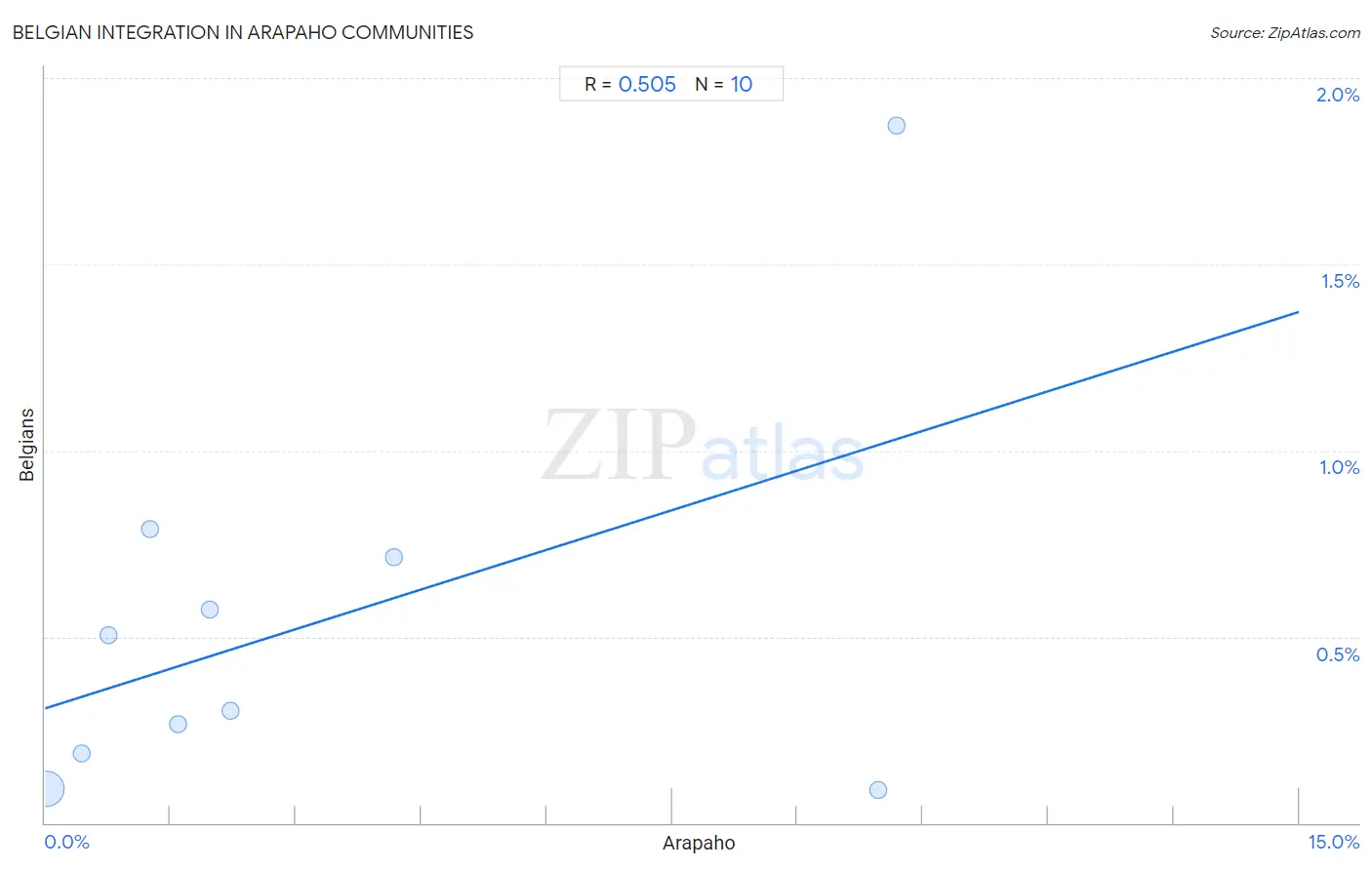
Arapaho vs Belgian Income
When considering income, the most significant differences between Arapaho and Belgian communities in the United States are seen in per capita income ($32,345 compared to $43,951, a difference of 35.9%), median male earnings ($41,758 compared to $55,361, a difference of 32.6%), and householder income ages 45 - 64 years ($75,945 compared to $100,060, a difference of 31.8%). Conversely, both communities are more comparable in terms of householder income over 65 years ($59,383 compared to $59,915, a difference of 0.90%), householder income under 25 years ($44,003 compared to $50,113, a difference of 13.9%), and median female earnings ($31,489 compared to $38,382, a difference of 21.9%).

| Income Metric | Arapaho | Belgian |
| Per Capita Income | Tragic $32,345 | Average $43,951 |
| Median Family Income | Tragic $82,064 | Average $102,788 |
| Median Household Income | Tragic $67,965 | Fair $84,008 |
| Median Earnings | Tragic $36,586 | Average $46,375 |
| Median Male Earnings | Tragic $41,758 | Good $55,361 |
| Median Female Earnings | Tragic $31,489 | Tragic $38,382 |
| Householder Age | Under 25 years | Tragic $44,003 | Tragic $50,113 |
| Householder Age | 25 - 44 years | Tragic $71,697 | Average $94,262 |
| Householder Age | 45 - 64 years | Tragic $75,945 | Average $100,060 |
| Householder Age | Over 65 years | Poor $59,383 | Fair $59,915 |
| Wage/Income Gap | Exceptional 23.5% | Tragic 28.8% |
Arapaho vs Belgian Poverty
When considering poverty, the most significant differences between Arapaho and Belgian communities in the United States are seen in single male poverty (21.9% compared to 13.5%, a difference of 62.1%), family poverty (12.7% compared to 8.0%, a difference of 59.1%), and married-couple family poverty (6.6% compared to 4.2%, a difference of 55.2%). Conversely, both communities are more comparable in terms of single mother poverty (33.4% compared to 29.7%, a difference of 12.7%), seniors poverty over the age of 75 (12.7% compared to 11.0%, a difference of 15.3%), and seniors poverty over the age of 65 (11.6% compared to 9.5%, a difference of 22.4%).
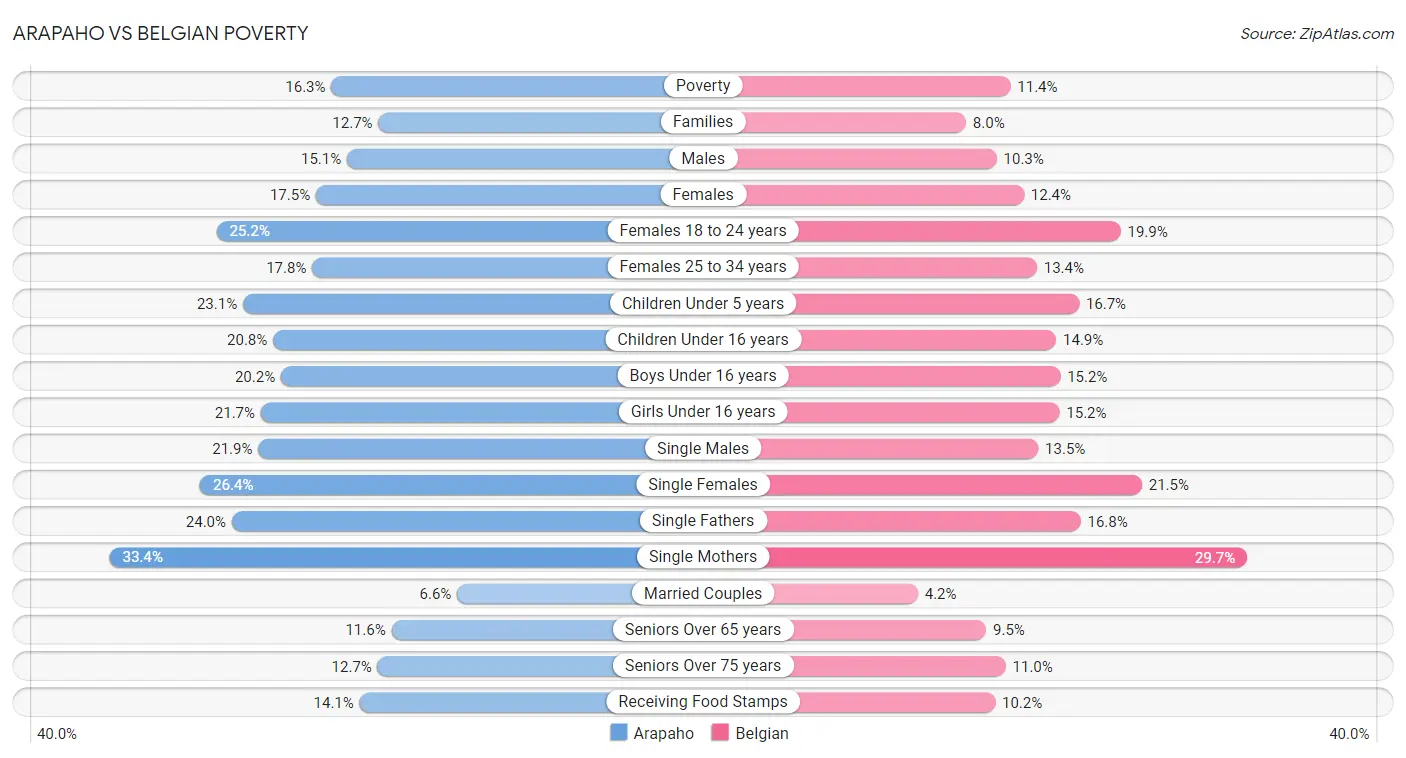
| Poverty Metric | Arapaho | Belgian |
| Poverty | Tragic 16.3% | Exceptional 11.4% |
| Families | Tragic 12.7% | Exceptional 8.0% |
| Males | Tragic 15.1% | Exceptional 10.3% |
| Females | Tragic 17.5% | Exceptional 12.4% |
| Females 18 to 24 years | Tragic 25.2% | Good 19.9% |
| Females 25 to 34 years | Tragic 17.8% | Average 13.4% |
| Children Under 5 years | Tragic 23.1% | Good 16.7% |
| Children Under 16 years | Tragic 20.8% | Exceptional 14.9% |
| Boys Under 16 years | Tragic 20.2% | Exceptional 15.2% |
| Girls Under 16 years | Tragic 21.7% | Exceptional 15.2% |
| Single Males | Tragic 21.9% | Tragic 13.5% |
| Single Females | Tragic 26.4% | Poor 21.5% |
| Single Fathers | Tragic 24.0% | Tragic 16.8% |
| Single Mothers | Tragic 33.4% | Poor 29.7% |
| Married Couples | Tragic 6.6% | Exceptional 4.2% |
| Seniors Over 65 years | Tragic 11.6% | Exceptional 9.5% |
| Seniors Over 75 years | Poor 12.7% | Exceptional 11.0% |
| Receiving Food Stamps | Tragic 14.1% | Exceptional 10.2% |
Arapaho vs Belgian Unemployment
When considering unemployment, the most significant differences between Arapaho and Belgian communities in the United States are seen in unemployment among women with children under 6 years (19.0% compared to 7.6%, a difference of 151.2%), unemployment among ages 30 to 34 years (12.8% compared to 5.1%, a difference of 149.8%), and unemployment among ages 25 to 29 years (15.4% compared to 6.3%, a difference of 144.1%). Conversely, both communities are more comparable in terms of unemployment among seniors over 65 years (5.3% compared to 4.8%, a difference of 9.6%), unemployment among ages 65 to 74 years (5.8% compared to 5.0%, a difference of 16.3%), and unemployment among seniors over 75 years (8.1% compared to 9.9%, a difference of 23.0%).
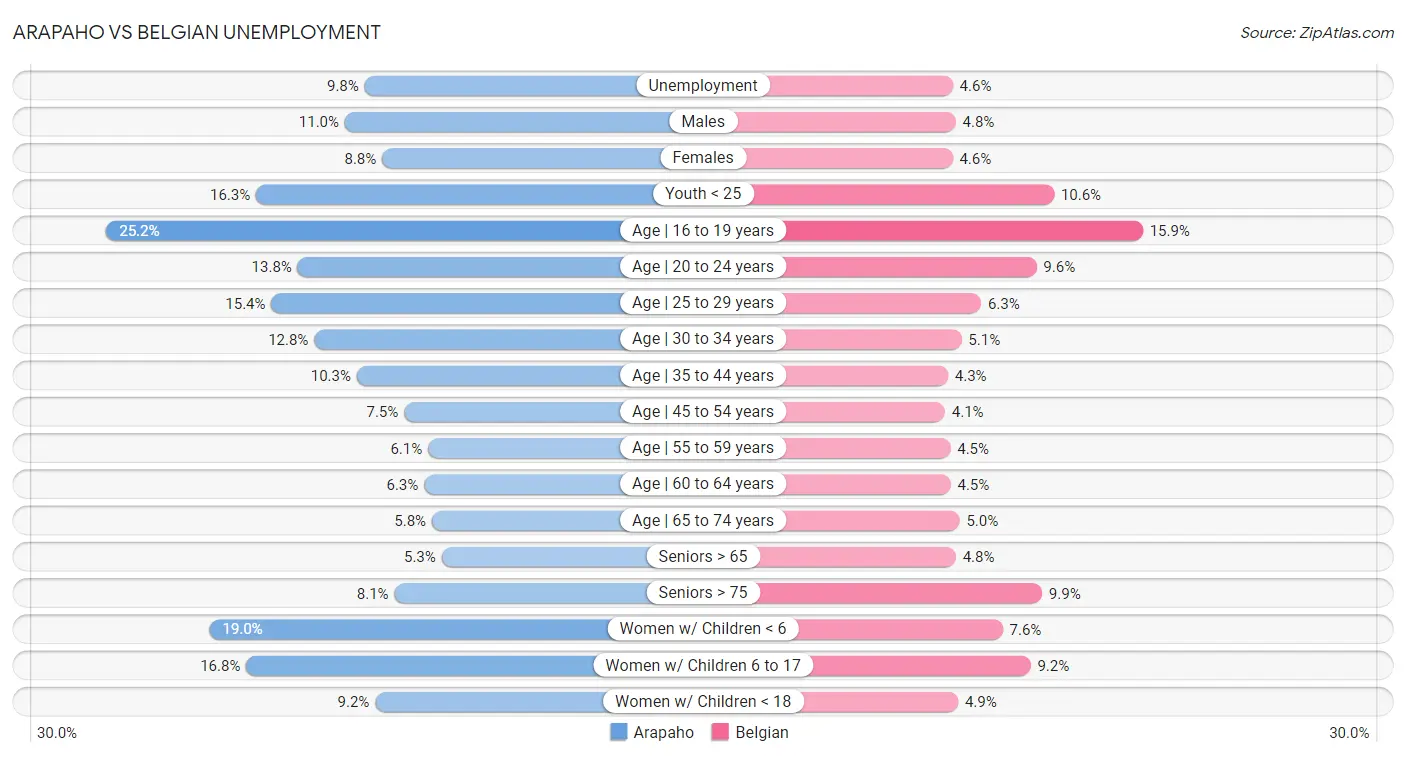
| Unemployment Metric | Arapaho | Belgian |
| Unemployment | Tragic 9.8% | Exceptional 4.6% |
| Males | Tragic 11.0% | Exceptional 4.8% |
| Females | Tragic 8.8% | Exceptional 4.6% |
| Youth < 25 | Tragic 16.3% | Exceptional 10.6% |
| Age | 16 to 19 years | Tragic 25.2% | Exceptional 15.9% |
| Age | 20 to 24 years | Tragic 13.8% | Exceptional 9.6% |
| Age | 25 to 29 years | Tragic 15.4% | Exceptional 6.3% |
| Age | 30 to 34 years | Tragic 12.8% | Exceptional 5.1% |
| Age | 35 to 44 years | Tragic 10.3% | Exceptional 4.3% |
| Age | 45 to 54 years | Tragic 7.5% | Exceptional 4.1% |
| Age | 55 to 59 years | Tragic 6.1% | Exceptional 4.5% |
| Age | 60 to 64 years | Tragic 6.3% | Exceptional 4.5% |
| Age | 65 to 74 years | Tragic 5.8% | Exceptional 5.0% |
| Seniors > 65 | Tragic 5.3% | Exceptional 4.8% |
| Seniors > 75 | Exceptional 8.1% | Tragic 9.9% |
| Women w/ Children < 6 | Tragic 19.0% | Good 7.6% |
| Women w/ Children 6 to 17 | Tragic 16.8% | Tragic 9.2% |
| Women w/ Children < 18 | Tragic 9.2% | Exceptional 4.9% |
Arapaho vs Belgian Labor Participation
When considering labor participation, the most significant differences between Arapaho and Belgian communities in the United States are seen in in labor force | age 16-19 (37.3% compared to 43.4%, a difference of 16.4%), in labor force | age 25-29 (76.6% compared to 85.5%, a difference of 11.7%), and in labor force | age 35-44 (78.1% compared to 84.9%, a difference of 8.7%). Conversely, both communities are more comparable in terms of in labor force | age > 16 (62.1% compared to 64.7%, a difference of 4.2%), in labor force | age 30-34 (81.5% compared to 85.2%, a difference of 4.6%), and in labor force | age 20-24 (73.8% compared to 77.8%, a difference of 5.4%).

| Labor Participation Metric | Arapaho | Belgian |
| In Labor Force | Age > 16 | Tragic 62.1% | Poor 64.7% |
| In Labor Force | Age 20-64 | Tragic 74.4% | Excellent 79.9% |
| In Labor Force | Age 16-19 | Excellent 37.3% | Exceptional 43.4% |
| In Labor Force | Age 20-24 | Tragic 73.8% | Exceptional 77.8% |
| In Labor Force | Age 25-29 | Tragic 76.6% | Exceptional 85.5% |
| In Labor Force | Age 30-34 | Tragic 81.5% | Exceptional 85.2% |
| In Labor Force | Age 35-44 | Tragic 78.1% | Exceptional 84.9% |
| In Labor Force | Age 45-54 | Tragic 77.1% | Exceptional 83.4% |
Arapaho vs Belgian Family Structure
When considering family structure, the most significant differences between Arapaho and Belgian communities in the United States are seen in births to unmarried women (47.1% compared to 31.6%, a difference of 49.1%), single father households (2.9% compared to 2.3%, a difference of 23.5%), and single mother households (7.1% compared to 5.8%, a difference of 21.5%). Conversely, both communities are more comparable in terms of family households (66.5% compared to 63.8%, a difference of 4.3%), family households with children (25.6% compared to 26.9%, a difference of 5.1%), and married-couple households (41.8% compared to 48.0%, a difference of 14.8%).

| Family Structure Metric | Arapaho | Belgian |
| Family Households | Exceptional 66.5% | Tragic 63.8% |
| Family Households with Children | Tragic 25.6% | Tragic 26.9% |
| Married-couple Households | Tragic 41.8% | Exceptional 48.0% |
| Average Family Size | Exceptional 3.64 | Tragic 3.11 |
| Single Father Households | Tragic 2.9% | Average 2.3% |
| Single Mother Households | Tragic 7.1% | Exceptional 5.8% |
| Currently Married | Tragic 40.5% | Exceptional 48.7% |
| Divorced or Separated | Tragic 14.8% | Tragic 12.3% |
| Births to Unmarried Women | Tragic 47.1% | Average 31.6% |
Arapaho vs Belgian Vehicle Availability
When considering vehicle availability, the most significant differences between Arapaho and Belgian communities in the United States are seen in 4 or more vehicles in household (9.4% compared to 6.8%, a difference of 38.2%), 3 or more vehicles in household (26.4% compared to 21.2%, a difference of 24.9%), and no vehicles in household (7.4% compared to 8.0%, a difference of 8.7%). Conversely, both communities are more comparable in terms of 1 or more vehicles in household (92.7% compared to 92.1%, a difference of 0.65%), 2 or more vehicles in household (60.2% compared to 59.3%, a difference of 1.7%), and no vehicles in household (7.4% compared to 8.0%, a difference of 8.7%).

| Vehicle Availability Metric | Arapaho | Belgian |
| No Vehicles Available | Exceptional 7.4% | Exceptional 8.0% |
| 1+ Vehicles Available | Exceptional 92.7% | Exceptional 92.1% |
| 2+ Vehicles Available | Exceptional 60.2% | Exceptional 59.3% |
| 3+ Vehicles Available | Exceptional 26.4% | Exceptional 21.2% |
| 4+ Vehicles Available | Exceptional 9.4% | Exceptional 6.8% |
Arapaho vs Belgian Education Level
When considering education level, the most significant differences between Arapaho and Belgian communities in the United States are seen in doctorate degree (1.2% compared to 1.8%, a difference of 57.7%), professional degree (2.9% compared to 4.3%, a difference of 50.1%), and master's degree (10.0% compared to 14.5%, a difference of 44.8%). Conversely, both communities are more comparable in terms of 3rd grade (98.4% compared to 98.3%, a difference of 0.050%), 4th grade (98.1% compared to 98.2%, a difference of 0.070%), and 5th grade (98.0% compared to 98.1%, a difference of 0.080%).
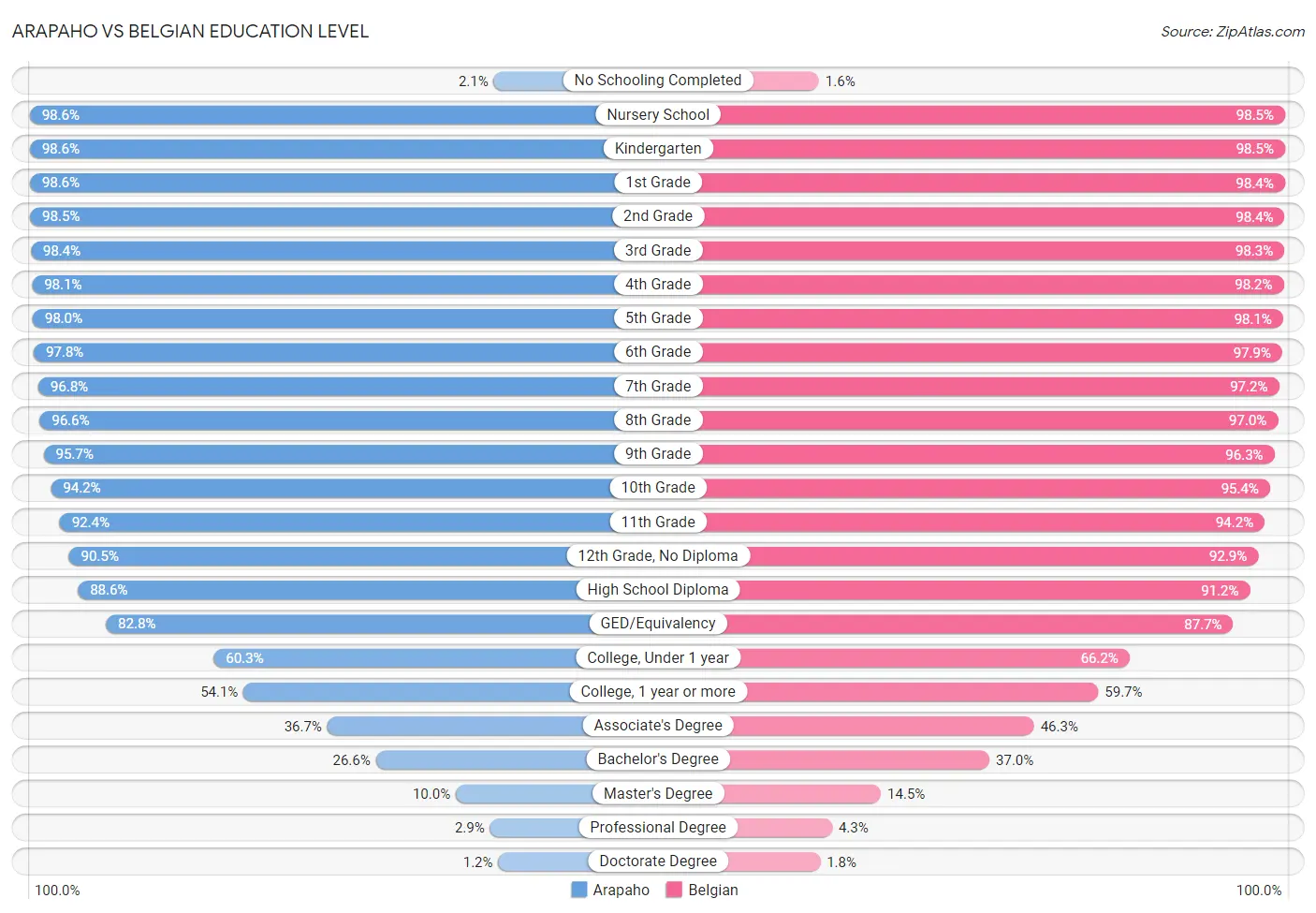
| Education Level Metric | Arapaho | Belgian |
| No Schooling Completed | Average 2.1% | Exceptional 1.6% |
| Nursery School | Exceptional 98.6% | Exceptional 98.5% |
| Kindergarten | Exceptional 98.6% | Exceptional 98.5% |
| 1st Grade | Exceptional 98.6% | Exceptional 98.4% |
| 2nd Grade | Exceptional 98.5% | Exceptional 98.4% |
| 3rd Grade | Exceptional 98.4% | Exceptional 98.3% |
| 4th Grade | Exceptional 98.1% | Exceptional 98.2% |
| 5th Grade | Exceptional 98.0% | Exceptional 98.1% |
| 6th Grade | Exceptional 97.8% | Exceptional 97.9% |
| 7th Grade | Exceptional 96.8% | Exceptional 97.2% |
| 8th Grade | Exceptional 96.6% | Exceptional 97.0% |
| 9th Grade | Exceptional 95.7% | Exceptional 96.3% |
| 10th Grade | Exceptional 94.2% | Exceptional 95.4% |
| 11th Grade | Fair 92.4% | Exceptional 94.2% |
| 12th Grade, No Diploma | Tragic 90.5% | Exceptional 92.9% |
| High School Diploma | Poor 88.6% | Exceptional 91.2% |
| GED/Equivalency | Tragic 82.8% | Exceptional 87.7% |
| College, Under 1 year | Tragic 60.3% | Good 66.2% |
| College, 1 year or more | Tragic 54.1% | Average 59.7% |
| Associate's Degree | Tragic 36.7% | Average 46.3% |
| Bachelor's Degree | Tragic 26.6% | Fair 37.0% |
| Master's Degree | Tragic 10.0% | Fair 14.5% |
| Professional Degree | Tragic 2.9% | Fair 4.3% |
| Doctorate Degree | Tragic 1.2% | Average 1.8% |
Arapaho vs Belgian Disability
When considering disability, the most significant differences between Arapaho and Belgian communities in the United States are seen in disability age 35 to 64 (15.1% compared to 11.7%, a difference of 28.7%), disability age 65 to 74 (28.1% compared to 22.7%, a difference of 23.5%), and vision disability (2.6% compared to 2.1%, a difference of 22.7%). Conversely, both communities are more comparable in terms of cognitive disability (16.8% compared to 16.7%, a difference of 0.83%), disability age 18 to 34 (7.1% compared to 7.4%, a difference of 3.7%), and female disability (13.0% compared to 12.5%, a difference of 4.3%).
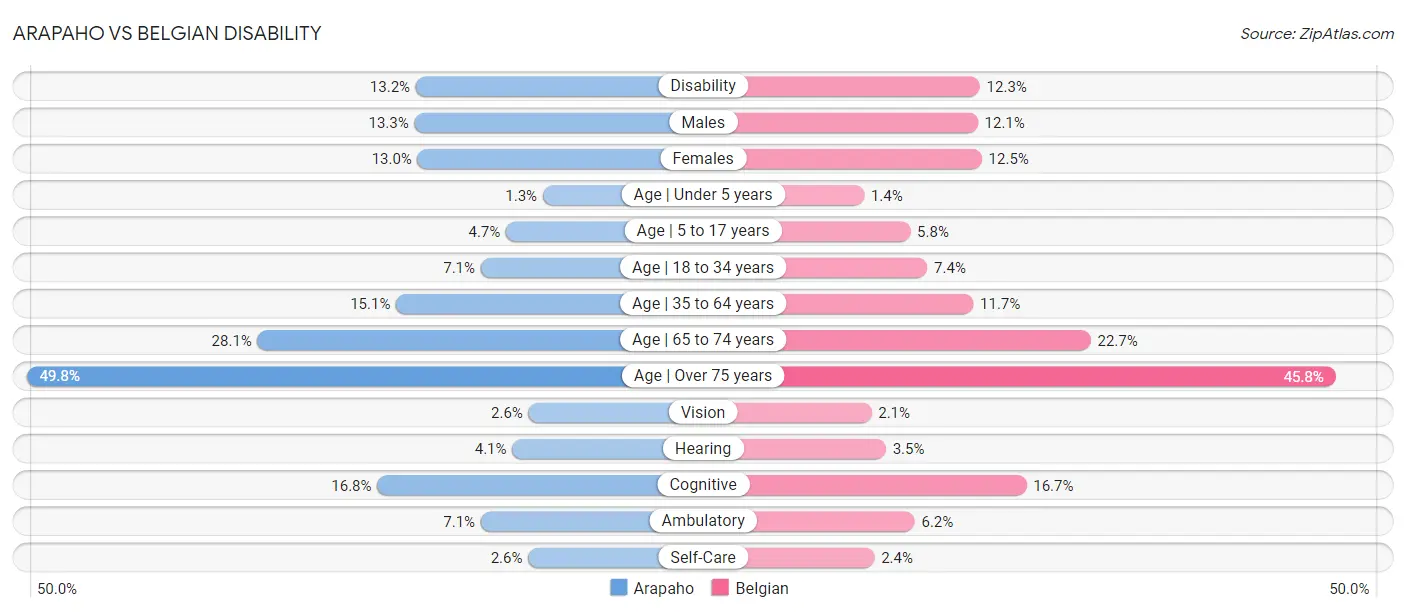
| Disability Metric | Arapaho | Belgian |
| Disability | Tragic 13.2% | Tragic 12.3% |
| Males | Tragic 13.3% | Tragic 12.1% |
| Females | Tragic 13.0% | Tragic 12.5% |
| Age | Under 5 years | Fair 1.3% | Tragic 1.4% |
| Age | 5 to 17 years | Exceptional 4.7% | Tragic 5.8% |
| Age | 18 to 34 years | Tragic 7.1% | Tragic 7.4% |
| Age | 35 to 64 years | Tragic 15.1% | Poor 11.7% |
| Age | 65 to 74 years | Tragic 28.1% | Excellent 22.7% |
| Age | Over 75 years | Tragic 49.8% | Exceptional 45.8% |
| Vision | Tragic 2.6% | Good 2.1% |
| Hearing | Tragic 4.1% | Tragic 3.5% |
| Cognitive | Exceptional 16.8% | Exceptional 16.7% |
| Ambulatory | Tragic 7.1% | Fair 6.2% |
| Self-Care | Tragic 2.6% | Exceptional 2.4% |